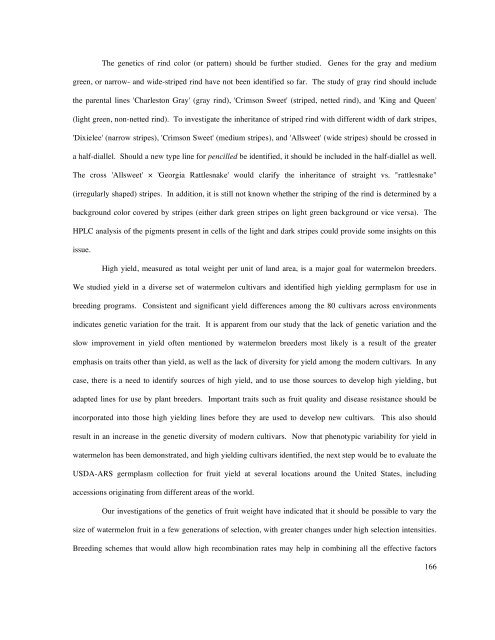Citrullus lanatus (Thunb.) Matsum. & Nakai - Cucurbit Breeding ...
Citrullus lanatus (Thunb.) Matsum. & Nakai - Cucurbit Breeding ...
Citrullus lanatus (Thunb.) Matsum. & Nakai - Cucurbit Breeding ...
Create successful ePaper yourself
Turn your PDF publications into a flip-book with our unique Google optimized e-Paper software.
The genetics of rind color (or pattern) should be further studied. Genes for the gray and medium<br />
green, or narrow- and wide-striped rind have not been identified so far. The study of gray rind should include<br />
the parental lines 'Charleston Gray' (gray rind), 'Crimson Sweet' (striped, netted rind), and 'King and Queen'<br />
(light green, non-netted rind). To investigate the inheritance of striped rind with different width of dark stripes,<br />
'Dixielee' (narrow stripes), 'Crimson Sweet' (medium stripes), and 'Allsweet' (wide stripes) should be crossed in<br />
a half-diallel. Should a new type line for pencilled be identified, it should be included in the half-diallel as well.<br />
The cross 'Allsweet' × 'Georgia Rattlesnake' would clarify the inheritance of straight vs. "rattlesnake"<br />
(irregularly shaped) stripes. In addition, it is still not known whether the striping of the rind is determined by a<br />
background color covered by stripes (either dark green stripes on light green background or vice versa). The<br />
HPLC analysis of the pigments present in cells of the light and dark stripes could provide some insights on this<br />
issue.<br />
High yield, measured as total weight per unit of land area, is a major goal for watermelon breeders.<br />
We studied yield in a diverse set of watermelon cultivars and identified high yielding germplasm for use in<br />
breeding programs. Consistent and significant yield differences among the 80 cultivars across environments<br />
indicates genetic variation for the trait. It is apparent from our study that the lack of genetic variation and the<br />
slow improvement in yield often mentioned by watermelon breeders most likely is a result of the greater<br />
emphasis on traits other than yield, as well as the lack of diversity for yield among the modern cultivars. In any<br />
case, there is a need to identify sources of high yield, and to use those sources to develop high yielding, but<br />
adapted lines for use by plant breeders. Important traits such as fruit quality and disease resistance should be<br />
incorporated into those high yielding lines before they are used to develop new cultivars. This also should<br />
result in an increase in the genetic diversity of modern cultivars. Now that phenotypic variability for yield in<br />
watermelon has been demonstrated, and high yielding cultivars identified, the next step would be to evaluate the<br />
USDA-ARS germplasm collection for fruit yield at several locations around the United States, including<br />
accessions originating from different areas of the world.<br />
Our investigations of the genetics of fruit weight have indicated that it should be possible to vary the<br />
size of watermelon fruit in a few generations of selection, with greater changes under high selection intensities.<br />
<strong>Breeding</strong> schemes that would allow high recombination rates may help in combining all the effective factors<br />
166
















